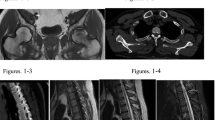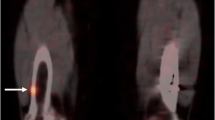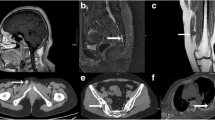Abstract
Phosphaturic mesenchymal tumors (PMTs) can present with vague symptoms of diffuse bone pain with pathologic fractures that often lead to a delayed diagnosis. We present a 60-year-old patient with a PMT that was persistently hypophosphatemic after resection, who was then successfully treated with cryoablation of the tumor. Tumor-induced osteomalacia (TIO) is a rare cause of hypophosphatemia characterized by vague symptoms of gradual muscle weakness and diffuse bone pain with pathologic fractures that often lead to a delayed diagnosis. This condition is usually caused by benign phosphaturic mesenchymal tumors (PMTs). Here, we present a case of persistent PMT after surgical resection treated with image-guided ablation. We present the patient’s clinical examinations and laboratory findings (phosphorus, 1,25 (OH)2d, FGF-23, Intact PTH). Representative histologic images of a PMT are also presented. A 61-year-old male was evaluated for persistent hypophosphatemia and presumed osteomalacia. Six years earlier, he underwent surgical excision of a left ischial mass after presenting with TIO. The pathology was consistent with a PMT; however, hypophosphatemia persisted suggesting incomplete resection. He was treated with calcitriol and phosphate salts. A PET Ga68 dotatate scan of the patient revealed an avid left ischial mixed lytic and sclerotic lesions with marked amount of radiotracer uptake, suggesting persistent tumor. The patient was resistant to re-excision of the tumor due to the extended recovery period from his prior surgery and was treated instead with cryoablation of the tumor. His biochemical findings of hypophosphatemia and elevated FGF23 resolved after the ablation and have remained normal for 5 months after surgery. In patients with TIO, wide surgical excision is the treatment of choice. When this is not possible, image-guided ablation is an alternative therapeutic option.

Similar content being viewed by others

Data availability
Data is available upon request.
References
Ghorbani-Aghbolaghi A, Darrow MA, Wang T (2017) Phosphaturic mesenchymal tumor (PMT): exceptionally rare disease, yet crucial not to miss. Autopsy Case Rep 7(3):32–37. https://doi.org/10.4322/acr.2017.031
McCance RA (1947) Osteomalacia with Looser’s nodes (Milkman’s syndrome) due to raised resistance to vitamin D acquired about the age of 15 years. Q J Med 16:33–46
Prader A, Illig J, Uehlinger E, Stalder G (1959) Rickets following bone tumor. Helv Paediatr Acta 14:554–565
Weidner N (1991) Review and update: oncogenic osteomalacia-rickets. Ultrastruct Pathol 15(4–5):317–333. https://doi.org/10.3109/01913129109016242
Boland JM, Tebben PJ, Folpe AL (2018) Phosphaturic mesenchymal tumors: what an endocrinologist should know. J Endocrinol Investig 41(10):1173–1184. https://doi.org/10.1007/s40618-018-0849-5
Drezner MK (2004) Tumor-induced osteomalacia. In: Favus MJ (ed) Primer on the metabolic bone diseases and disorders of mineral metabolism, 4th edn. Lippincott Williams, Wilkins, Philadelphia, pp 331–337
Hori M, Shimizu Y, Fukumoto S (2011) Minireview: fibroblast growth factor 23 in phosphate homeostasis and bone metabolism. Endocrinology. 152:4–10
Hesse E, Rosenthal H, Bastian L (2007) Radiofrequency ablation of a tumor causing oncogenic osteomalacia. N Engl J Med 357(4):422–424
Ruppe MD, Jan de Beur SM (2008) Disorders of phosphate homeostasis. In: Rosen CJ (ed) Primer on the metabolic bone diseases and disorders of mineral metabolism, 7th edn. American Society of Bone and Mineral Research, Washington DC, pp 317–325
El-Maouche D, Sadowski SM, Papadakis GZ, Guthrie L, Cottle-Delisle C, Merkel R, Millo C, Chen CC, Kebebew E, Collins MT (2016) 68Ga-DOTATATE for tumor localization in tumor-induced osteomalacia. J Clin Endocrinol Metab 101(10):3575–3581. https://doi.org/10.1210/jc.2016-2052
Andreopoulou P, Dumitrescu CE, Kelly MH, Brillante BA, Cutler Peck CM, Wodajo FM, Chang R, Collins MT (2011) Selective venous sampling for the localization of phosphaturic mesenchymal tumors. J Bone Miner Res 26:1295–1302
Jahdav S, Kasaliwal R, Shetty NS, Kulkarni S et al (2014) Radiofrequency ablation, an effective modality of treatment in tumor-induced osteomalacia: a case series of three patients. J Clin Endocrinol Metab 99(9):3049–3054. https://doi.org/10.1210/jc.2013-4515
Tutton S, Olson E, King D, Shaker JL (2012) Successful treatment of tumor-induced osteomalacia with CT-guided percutaneous ethanol and cryoablation. J Clin Endocrinol Metab 97:3421–3425
Igney-Oertel A, Artunc F, Henes J, Hoffmann R, Clasen S (2016) Osteomalacia by a mesenchymal-FGF23-producing tumour: successful treatment with radiofrequency ablation. A case report. Joint Bone Spine 83(5):603–604. https://doi.org/10.1016/j.jbspin.2015.09.011
Tella SH, Amalou H, Wood BJ, Chang R, Chen CC, Robinson C, Millwood M, Guthrie LC, Xu S, Levy E, Krishnasamy V, Gafni RI, Collins MT (2017) Multimodality image-guided cryoablation for inoperable tumor-induced osteomalacia. J Bone Miner Res 32(11):2248–2256
Mishra SK, Kuchay MS, Sen IB, Garg A, Baijal SS, Mithal A (2019) Successful management of tumor-induced osteomalacia with radiofrequency ablation: a case series. JBMR Plus 3(7):e10178. https://doi.org/10.1002/jbm4.10178
Walton RJ, Bijvoet OLM (1975) Nomogram for derivation of renal threshold phosphate concentration. Lancet i:309–310
Park YK et al (1994) Oncogenic Osteomalacia: a Clinicopathologic Study of 17 Bone Lesions. J Korean Med Sci 9(4):289. https://doi.org/10.3346/jkms.1994.9.4.289
Yavropoulou MP et al (2018) Distant lung metastases caused by a histologically benign phosphaturic mesenchymal tumor. Endocrinol Diabetes Metab Case Rep 2018. https://doi.org/10.1530/edm-18-0023
Li X, Jiang Y, Huo L, Wu H, Liu Y, Jin J, Yu W, Lv W, Zhou L, Xia Y, Wang O, Li M, Xing X, Chi Y, Jiajue R, Cui L, Meng X, Xia W (2020) Nonremission and recurrent tumor-induced osteomalacia: a retrospective study. J Bone Miner Res 35(3):469–477. https://doi.org/10.1002/jbmr.3903
Funding
This research was funded by Medical College of Wisconsin’s Department of Orthopedic Surgery.
Author information
Authors and Affiliations
Contributions
All authors provided substantial contributions to conception and design, or acquisition of data, or analysis and interpretation of data in preparing this manuscript.
Corresponding author
Ethics declarations
Conflict of interest
Dr Sean Tutton is a consultant for Galil Medical, consultant for Stryker, consultant for IZI Medical, and provides research support for Siemens. Dr Joseph Shaker receives authorship royalties from McGraw-Hill and is a consultant for Shire, Alexion, and Ultragenyx. Jonathan Horng, Erik Van Eperen, Reena Singh, and Adam Wooldridge declare that they have no conflicts of interest.
Ethics approval
(Include appropriate approvals or waivers)
Consent to participate
(Include appropriate statements)
Consent for publication
(Include appropriate statements)
Code availability
Not applicable.
Additional information
Publisher’s note
Springer Nature remains neutral with regard to jurisdictional claims in published maps and institutional affiliations.
Supplementary information
Supplementary Figure 1
MRI demonstrates a heterogeneous lesion at the posterior medial aspect of the acetabulum extending into the ischium with a convex margin at the medial aspect of the acetabulum which likely corresponds with the area of cortical deficiency on the prior CT. There is enhancement in this location as well as at the inferior aspect of the lesion corresponding with the more lytic areas on the CT performed a few hours prior. (PNG 307 kb)
Supplementary Figure 2
CT multi-planar reformat obtained in real-time during biopsy and ablation demonstrating the coaxial bone trochar and cryoablation probe positioned in the center of the lesion. Navigational lines are not shown so as not to obscure the lesion. (PNG 181 kb)
Rights and permissions
About this article
Cite this article
Horng, J.C., Van Eperen, E., Tutton, S. et al. Persistent phosphaturic mesenchymal tumor causing tumor-induced osteomalacia treated with image-guided ablation. Osteoporos Int 32, 1895–1898 (2021). https://doi.org/10.1007/s00198-020-05795-1
Received:
Accepted:
Published:
Issue Date:
DOI: https://doi.org/10.1007/s00198-020-05795-1



